
Spectators
Who Will Be Here Competing?
The 2024 Kentucky Classic Combined Driving Event is eager to host an elite group of drivers from around the country. Come cheer them on as they compete with their equine partner(s).
There is plenty of room to get close to the action. You may wish to bring your own chair though, in case you would like to sit down and watch, as seating is not provided.
How do I get to the 2021 Kentucky Classic CDE at Hillcroft Farm?
Enter the following address into your GPS:
238 Tarr Road
Paris, Kentucky 40361
Once you turn onto Tarr Road, it will be the first set of Hillcroft Farm gates on your left. Directional signage will also be present to assist you, and direct you to the spectator parking area.
Where to Stay While Visiting Us
The nearest hotel is the Best Western Paris Inn, located at:
2011 Alverson Drive
Paris, KY 40361
(859)-987-0779
18091@hotel.bestwestern.com
There are additional hotels located in the area:
Lexington
Clarion Lexington – North (859)-233-0512
Embassy Suites Lexington (859)-455-5000
Fairfield Inn (859)-977-5870
Griffin Gate Marriott Resort & Spa (859)-231-5100
La Quinta Inn (859)-231-7551
Georgetown
Best Western (502)-863-1586
Hampton Inn (502)-867-4888
Super 8 (502)-863-4888
There are also many local B&B’s available in the Paris area! Some are listed here
If you are a local that has a place for rent and would like your information posted here, please contact KYClassicCDEHillcroft@gmail.com.
What is a Combined Driving Event?
- Driving as a sport and pastime grew out of the practicalities of the past, when horse-drawn transportation was the best, if not only, form of travel.
- The sport of combined driving was developed in the 1960’s, modeled after the popular equestrian discipline of eventing. This unique discipline of equine competition unites athleticism, speed, and extreme horsepower, with the grace and beauty of a bygone era.
- The rules governing the sport of combined driving were created by the Federation Equestre Internationale (FEI) in the late 1960’s. At that time, drivers in Europe were competing at events similar to today’s driving competitions – but there was virtually no consistency in how these competitions were being judged or regulated. The FEI and its then-president, HRH Prince Phillip (an avid driver himself), realized that this emerging sport needed consistent rules and standards in order to have any hope of growth or a future World Championship. The rules were duly written and, in 1970, combined driving was officially recognized as the FEI’s fourth international equestrian sport. Since then, the FEI has created World Championships in all of the various driving divisions: single, pair, and four-in-hand teams of both horses and ponies. The United States Equestrian Federation (USEF), the governing body for the sport in the United States, also created National Championships in all of these divisions.
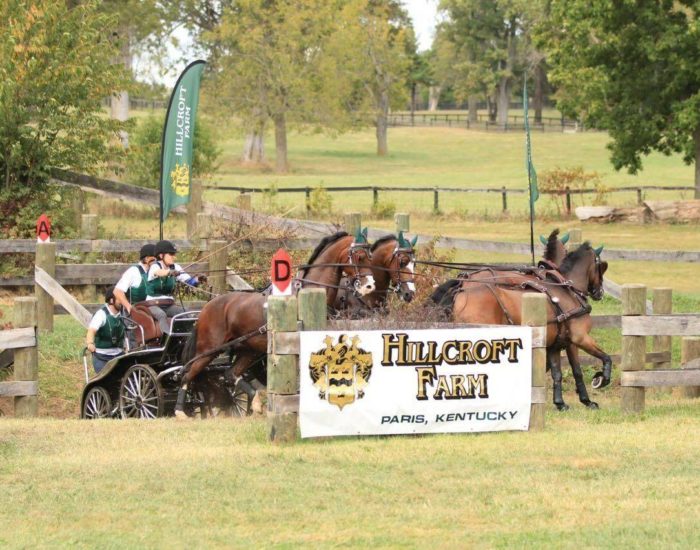
Three Phases of Competition
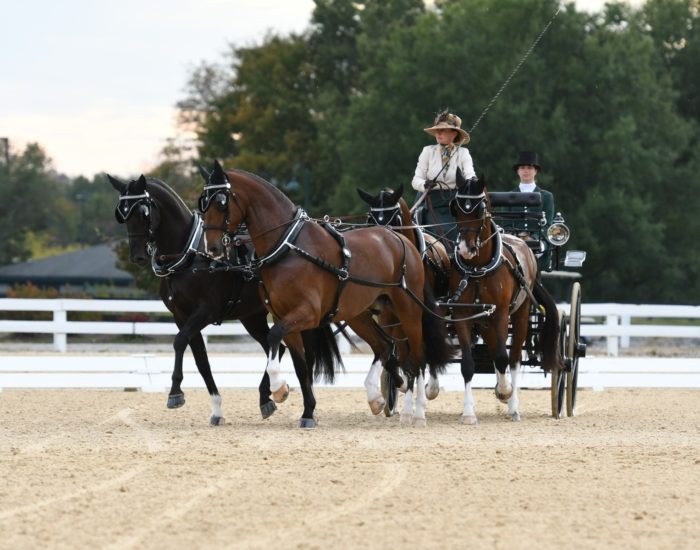
Phase One: Dressage
The “Dressage” phase is scored much like ridden dressage. During a dressage test, each driver and his or her horse(s) or ponies should work together as a team. They will perform a set pattern of movements, each being scored from 0 to 10 (the higher score being preferable) by a judge. The judge(s) are looking for: regularity of gait, correctness, accuracy of movement, harmony, suppleness, etc. The competitors also receive scores for “general impression” and “presentation” (i.e. appropriate dress on both the driver and his or her groom(s), condition and cleanliness of the harness and vehicle, etc.).
Each of the judges’ scores are then added together for an overall total score, which are then averaged and converted to a “penalty-point” score. The lower the score, the better.
For this phase, many competitors use traditional-looking carriages. The driver and his or her groom(s) are dressed to conform to long-standing carriage driving traditions – hats, gloves, and driving aprons on the drivers, and matching traditional livery on the groom(s). Groom(s) are unable to assist the driver in completing the dressage test.
Phase Two: Marathon
The marathon phase of combined driving, similar to the cross country phase of eventing, is judged primarily on time. The object of this phase is to go as quickly as possible through each of the obstacles. Smooth and steady usually beats overly fast with too-sharp turns. But a driver who spends more than five minutes in any particular obstacle is eliminated.
In the marathon phase, each obstacle includes up to six lettered “gates” – with the correct direction that a driver must pass through each gate marked by red on the right and white on the left. Before the marathon phase, each driver will have all walked the course numerous times in order to determine their preferred route. The gates in each obstacle must be negotiated in the proper order (A, then B, then C, etc.), and missing a gate equals elimination.
The marathon score is determined by adding the driver’s times in each obstacle to any course and/or time penalties (which are levied for coming in sooner than the minimum time or after the maximum time allowed) they may have incurred while out on course.
Unlike in the dressage phase, the groom(s) or “navigator(s)” on the back of each carriage are allowed to assist the driver. They will have walked the course with the driver prior to the competition, and can help the driver directionally. They also often act as ballast, hanging off the back or sides of the carriage through especially tight turns, They are not, however, allowed to get off the carriage without incurring additional penalties. Single and pair competitors will have one navigator on the back of their carriage, while four-in-hand drivers will have two – the “top step” and the “bottom step.” The top step navigator helps the driver watch his or her horses, sort of like a back seat driver. They help the driver stay on the correct path by guiding them through the obstacle.
The bottom step navigator is the ballast, and can jump the carriage around a post if a driver gets too close. They also keep time for the driver to make sure they complete the course in optimum time so as not to occur any time penalties. All participants – both driver and groom(s) – are required to wear a safety vest and helmet.
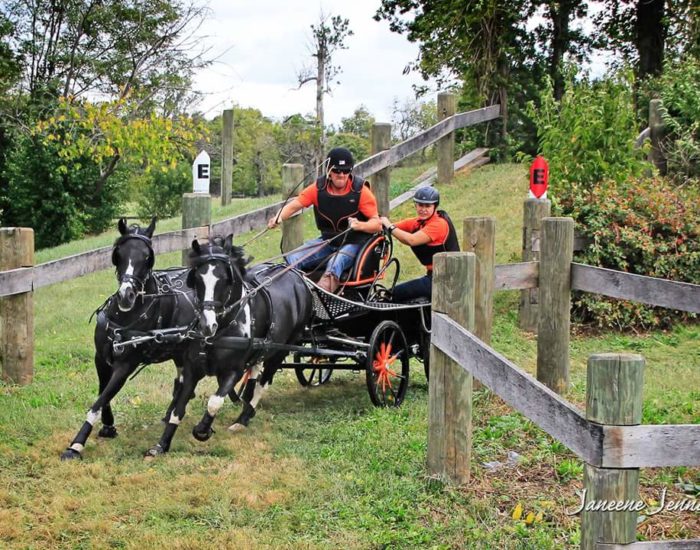
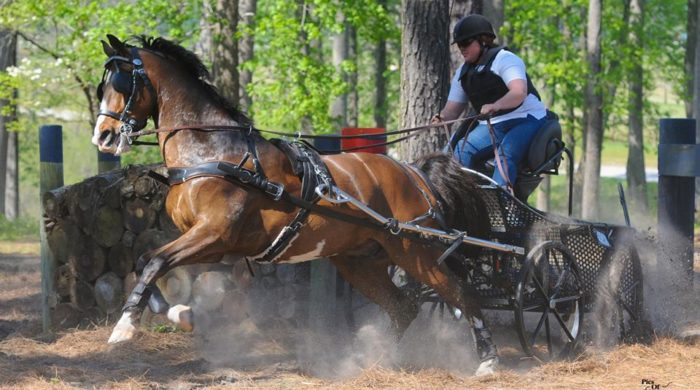
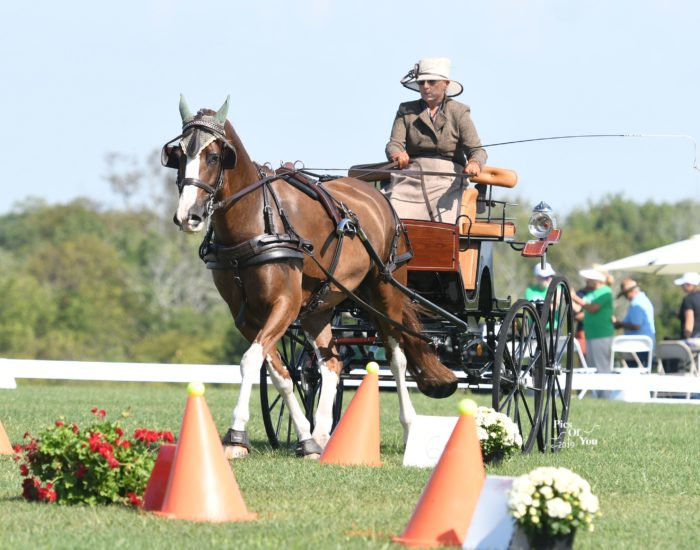
Phase Three: Cones
On the final day of a combined driving event, the cones competition tests the horses’ and ponies’ agility, speed, and obedience.
The drivers must navigate a complex course of twists and turns, marked by pairs of modified traffic cones, with a ball balanced on top of each cone. With mere centimeters of clearance between the carriage wheels and the cones, precision is key. Each ball (or pair of balls at a single gate) knocked down by an errant hoof or carriage wheel incurs three penalty points. Further penalties are added to a driver’s score for exceeding the time allowed.
Competitors will use the same carriage they used for the dressage phase, and will again dress to conform to the long-standing carriage driving traditions – hats, gloves, and driving aprons on the drivers, and matching traditional livery on the groom(s). But unlike in the dressage phase, groom(s) may assist their driver and help them navigate the course. They are required to remain in their seat, though, or else they could incur penalties on their driver’s final score.
